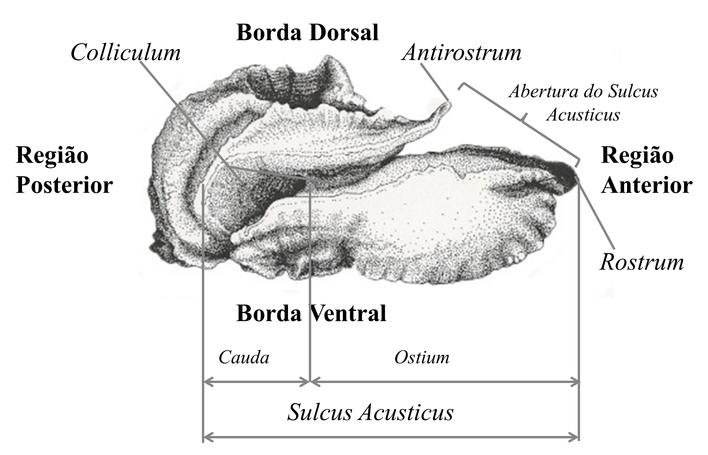The collection
The teleost species were identified in accordance with Figueiredo and Menezes (1978; 1980; 2000), Menezes and Figueiredo (1980; 1985), Figueiredo et al. (2002), Menezes et al. (2003), Bernardes et al. (2005) and Nelson (2006).
The left otolith of each pair was used for the measurements and photographs. Whenever they were available in the collection, 3 representative otoliths of the smallest, intermediate and largest fishes were selected for the illustrations and photographs in order to describe ontogenetic variations.
The otoliths were covered with graphite powder to bring out their features, and illustrations of the internal and external sides and profile of the ventral region of these structures were drawn.
The illustrations were performed with the assistance of a light box under incident light and subsequently drawn with ink on tracing paper by using the pointillism technique. Drawings were then digitized, and the plates were organized by each species. Subsequently to the illustration, the same otoliths were photographed in identical positions by using the Discovery V12 Carl Zeiss equipment.

The criteria to assess the otoliths' characteristics followed the terminology by Assis (2004) and Tuset et al. (2008). Each otolith was analyzed by 3 researchers using a stereomicroscope, and the following features were examined: 1) the otoliths shape, 2) shape of the anterior region, 3) shape of the posterior region, 4) dorsal and ventral edges, 5) position of the sulcus acusticus, 6) orientation of the sulcus acusticus, 7) opening of the sulcus acusticus, 8) morphology of the sulcus acusticus, 9) morphology of the colliculum, 10) morphology of the ostium, 11) morphology of the cauda, 12) otoliths profile, 13) orientation of the rostrum and antirostrum, 14) development of the rostrum and antirostrum and 15) development of the pseudorostrum and pseudo- antirostrum. Following the analysis of the otolith set performed by the 3 researchers, the results attained for each characteristic were organized into tables and graphs. For each of the 15 characteristics, the frequency of occurrence according to the length class and total were calculated, and a multiple X2 test with confidence level of 0.05 (Zar, 2010), was applied to identify the possible structural differences throughout the development of a species (when n > 10).
To perform the morphometric analysis of the sagittae, it was also used the same otoliths analyzed for the morphology, thus attaining data for the length (OL largest distance of the anteroposterior axis), height (OH largest distance of the dorsal ventral axis), thickness (OT maximum width of the otolith). The perimeter and area were attained from photographs of the inner and ventral profiles of the structures. Data collection was assisted by the AxioVision 4.8 software embedded in a Discovery V12 Carl Zeiss equipment. An analysis of the measurements attained for each species was conducted following the method proposed by Tuset et al. (2006; 2008).
Data of the perimeter and area were used to calculate the circularity (Ci) and/or the rectangularity indices: Ci = Cē/A (where, Ci= circularity, C= perimeter, and A= area) and Re=A/(OL x OH) (where Re= rectangularity, A= area, OL= otolith length, and OH= otolith height). The shape rates were calculated using the ratios of the measurements of the otoliths, namely, the lengths of the otoliths and the lengths of the fish: OL/TLx100 (where OL=otolith length and TL=total length of the fish), OL/OHx100 (where OH=otolith height), OL/OTx100 (where OT=otolith thickness) and OH/OTx100. In the plates, the otoliths identification (ID) is shown according to the fish's reference in the COSS-Brasil database.





